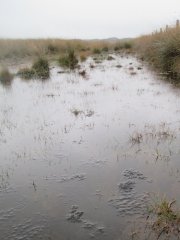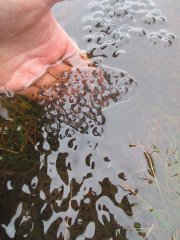 The common frog Rana temporaria is a familiar sight across the UK. In any shallow standing water you are likely to come across tell-tale clumps of spawn, and tadpoles and froglets vying for survival, not above eating their siblings if needs must!
The common frog Rana temporaria is a familiar sight across the UK. In any shallow standing water you are likely to come across tell-tale clumps of spawn, and tadpoles and froglets vying for survival, not above eating their siblings if needs must!
But just when can you expect to find frogspawn and tadpoles in your local pond? The simple answer might be spring for spawn, and summer for tadpoles, but delve deeper and this doesn't quite stand up to scrutiny.
Here on the Lizard, in the far south-west of the UK, our mild climate gives lots of species a head start, but our frogs have taken this further than most! This year I first saw frog spawn on 21st November, which is early, but not unheard of in a Cornish context.
 The gamble of getting ahead in the breeding game must be worth taking, and the risk of a severe cold-snap which could freeze the spawn worth braving. The Lizard is famed for its rare plants, and one of our speciality habitat types is grandly titled Mediterranean temporary ponds, home to the grass-like fern pillwort, three-lobed water crowfoot, tiny 1cm-high pygmy rush and yellow centaury. More humbly called puddles, these shallow pools within the cart tracks that crisscross the clayey heathlands are also ideal breeding habitat for frogs, being free of predators like fish that require permanent water. However, a puddle that dries up before the spawn reaches froglet stage wasn't such a wise bet! This is where the very earliest pre-Christmas spawn may have the advantage, as the spring breeders are at greater risk of being left high and dry.
The gamble of getting ahead in the breeding game must be worth taking, and the risk of a severe cold-snap which could freeze the spawn worth braving. The Lizard is famed for its rare plants, and one of our speciality habitat types is grandly titled Mediterranean temporary ponds, home to the grass-like fern pillwort, three-lobed water crowfoot, tiny 1cm-high pygmy rush and yellow centaury. More humbly called puddles, these shallow pools within the cart tracks that crisscross the clayey heathlands are also ideal breeding habitat for frogs, being free of predators like fish that require permanent water. However, a puddle that dries up before the spawn reaches froglet stage wasn't such a wise bet! This is where the very earliest pre-Christmas spawn may have the advantage, as the spring breeders are at greater risk of being left high and dry.
Thanks to the long history of phenology in the UK, in which the date of first frog spawn features strongly, records like this from the Lizard can be put to good use. The UK phenology network has morphed in recent years into the website www.naturescalendar.org.uk, hosted by the Woodland Trust, and supported by a huge network of enthusiastic amateurs submitting records ranging from first bluebell of the year to first redwing and last swallow. This website has some excellent time lapse maps showing frogspawn's march north and eastwards in any given Spring. 70,000 first frog spawn UK dates 1998-2007 were analysed and this revealed that, starting in the far south west, spawn took 7.5 days to 'march' 100km eastwards, and 5 days to advance 100km northwards. Comparison with data from 60 years before showed spawning to be 10 days earlier, a symptom of global warming, as early spring temperatures are a critical control on spawning dates.
This website has some excellent time lapse maps showing frogspawn's march north and eastwards in any given Spring. 70,000 first frog spawn UK dates 1998-2007 were analysed and this revealed that, starting in the far south west, spawn took 7.5 days to 'march' 100km eastwards, and 5 days to advance 100km northwards. Comparison with data from 60 years before showed spawning to be 10 days earlier, a symptom of global warming, as early spring temperatures are a critical control on spawning dates.
CARROLL, E. A., SPARKS, T. H., COLLINSON, N. and BEEBEE, T. J. C. (2009), Influence of temperature on the spatial distribution of first spawning dates of the common frog (Rana temporaria) in the UK. Global Change Biology, 15
And for tadpoles? Don't be surprised if you find them in December too! Reports of tadpoles overwintering in ponds have been reported from Cornwall and Kent in the south, to Aberdeen in the north (see www.theguardian.com/theguardian/2010/nov/17/tadpoles-over-winter-in-pond). Research from Edinburgh and Glasgow Universities suggests this isn't, as was once thought, a case of tadpoles failing to make the grade, but more a strategy chosen to allow the individuals to get ahead as, when they finally become frogs in Spring, they are a larger size. Some individuals may be taking advantage of the milder winter temperatures, from global warming, to become bigger tadpoles and hence larger frogs.
Published: Dec 2014
Author: Rachel Holder (Area Ranger, The Lizard)
